What is Fiber Color Codes?
Fiber color code is a standard for quickly identifying fibers, cables, connectors and fiber optic assemblies. The Telecommunications Industry Association (TIA) especially launched the TIA-598 standard. This standard addresses the manufacturer’s fiber color codes to follow and reference.
Let’s introduce fiber optic color codes from this 3 main aspects. We also believe this PDF from TheFOA.org code codes is helpful, You can also download it.

Why Use Fiber Optic Color Codes?
Using the right fiber color codes makes it easier for technicians to handle and fix fiber optic cables quickly. Network managers can easily tell apart different fiber types and get their details just by checking the color code. This avoids unnecessary checks and cuts down on the time it takes to set up and maintain things.

In today’s fast-paced data centers, where cables with many fibers are common, keeping track of all these connections is crucial. A single device might be linked to dozens or even hundreds of fibers. So, being able to identify each fiber easily is very important. Good color coding of fibers helps keep the network running smoothly, lowers the chance of it going down, and makes the network more reliable. Plus, it makes adding to the network or upgrading it much simpler.
Standards For Color Codes
There is a color code standard in TIA, TIA-598 that addresses fiber optic color codes, which most manufacturers adopt and reference, although there are many exceptions based on customer requirements or preferences. Here is what TIA-598 recommends:
| EIA598-A Individual Fiber Colour | DIN VDE 0888 Individual Fiber Colour | IEC 60794-2 Individual Fiber Colour | IEC 60304 Individual Fiber Colour |
|---|---|---|---|
| 1 Blue | 1 Red | 1 Blue | 1 Red |
| 2 Orange | 2 Green | 2 Yellow | 2 Green |
| 3 Green | 3 Blue | 3 Red | 3 Blue |
| 4 Brown | 4 Yellow | 4 White | 4 Yellow |
| 5 Slate | 5 White | 5 Green | 5 White |
| 6 White | 6 Slate | 6 Violet | 6 Slate |
| 7 Red | 7 Brown | 7 Orange | 7 Brown |
| 8 Black | 8 Violet | 8 Slate | 8 Violet |
| 9 Yellow | 9 Aqua | 9 Aqua | 9 Aqua |
| 10 Violet | 10 Black | 10 Black | 10 Black |
| 11 Pink | 11 Orange | 11 Brown | 11 Orange |
| 12 Aqua | 12 Pink | 12 Pink | 12 Pink |
| 13 Blue* | 13 Red* | 13 | 13 Red* |
| 14 Orange* | 14 Green* | 14 | 14 Green* |
| 15 Green* | 15 Blue* | 15 | 15 Blue* |
| 16 Brown* | 16 Yellow* | 16 | 16 Yellow* |
| 17 Slate* | 17 White* | 17 | 17 White* |
| 18 White* | 18 Grey* | 18 | 18 Slate* |
| 19 Red* | 19 Brown* | 19 | 19 Brown* |
| 20 Black** | 20 Violet* | 20 | 20 Violet* |
| 21 Yellow* | 21 Aqua* | 21 Buffer 1 Red | 21 Aqua* |
| 22 Violet* | 22 Transparent | 22 Buffer 2 Green | 22 Transparent* |
| 23 Pink* | 23 Orange* | 23 Transparent | 23 Orange* |
| 24 Aqua* | 24 Pink* | 24 Transparent | 24 Pink* |
Fiber Color Code for Inner Fiber ( By Fiber Counts )
6 and 12 cores fiber color code
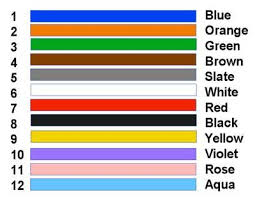
24 cores fiber color code
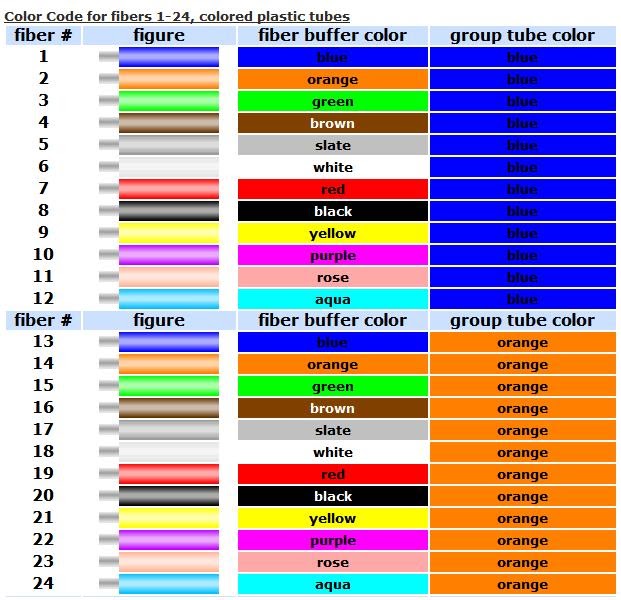
48 cores fiber color code
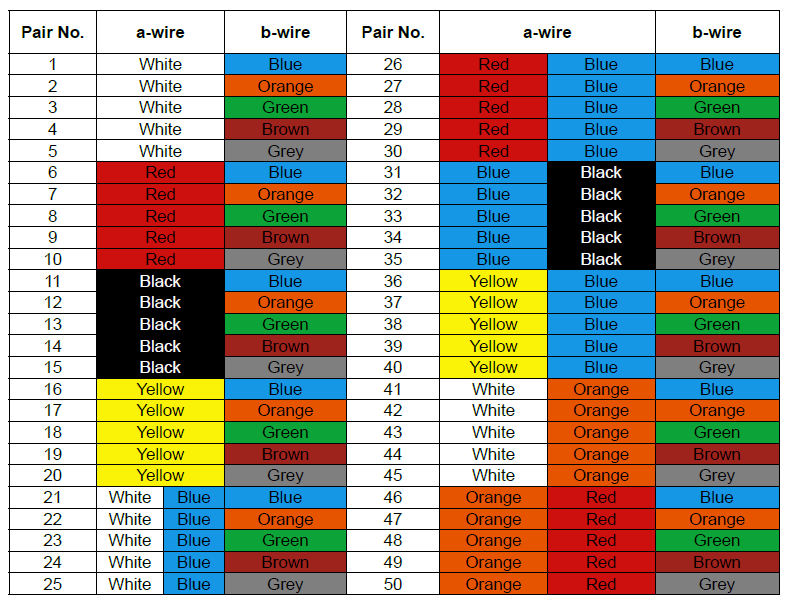
144 cores fiber color code

288 cores fiber color code
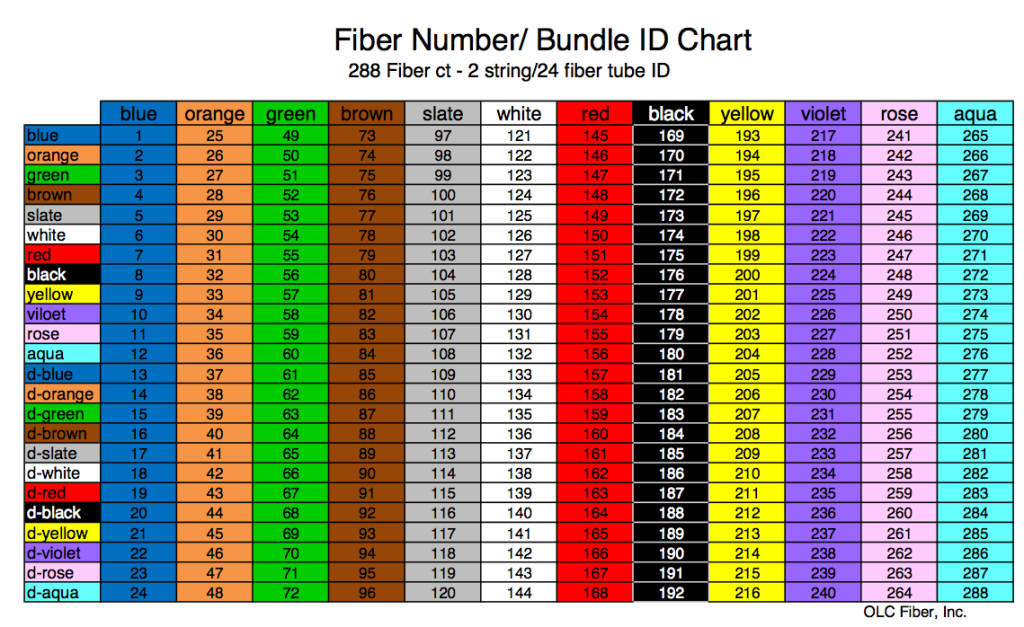
432 cores fiber color code
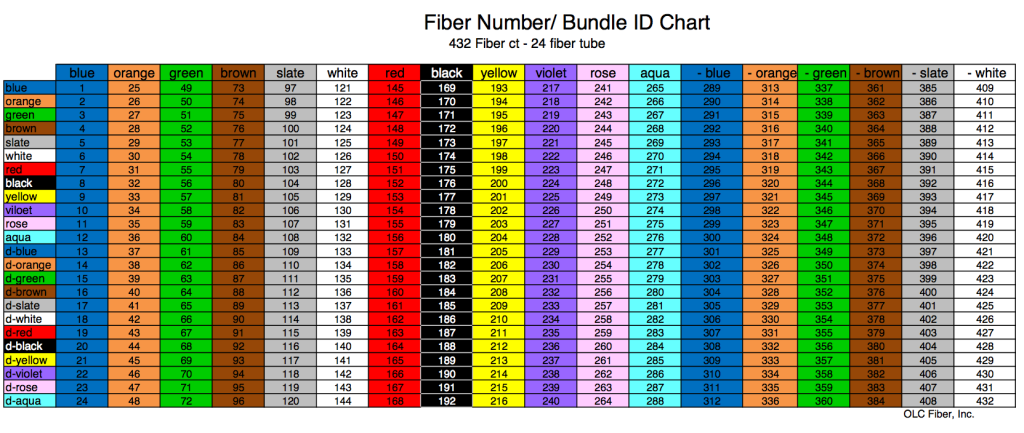
Fiber Color Code for Fiber Connectors & Assemblies
Fiber Color Code for Fiber Connectors such as SC LC FC ST
As FC ST is of metallic body, so the color you can see is their boot.
| Fiber type | Connector Body | Strain Relief/ Mating Adapter |
| 62.5/125 | Beige | Beige |
| 50/125 OM2 | Black | Black |
| 50/125 laser optimized (OM3, OM4) | Aqua | Aqua |
| OM5 wideband fiber | Lime | Lime |
| Singlemode | Blue | Blue |
| Singlemode APC | Green | Green |
Fiber Color Code for Cable Jacket

Simple but Valueable Table for Fiber Assemblies Color Code
Color codes make it easy to tell what kind of connector a fiber optic patch cord has. For example, the older types of multimode fibers, OM1 and OM2, are usually beige or black. The newer, better performing OM3 and OM4 fibers are colored aqua and magenta.
For single mode fibers, blue means the connector is UPC, and green means it’s APC. It’s really important not to mix UPC and APC connectors because they won’t work well together.
| Fiber Connector | Polishing Type | Fiber Type | Connector Color | Fiber Color Code |
|---|---|---|---|---|
| LC | UPC | Singlemode | Blue | Yellow |
| LC | APC | Singlemode | Green | Yellow |
| SC | UPC | Singlemode | Blue | Yellow |
| SC | APC | Singlemode | Green | Yellow |
| ST | UPC | Singlemode | Black | Yellow |
| ST | APC | Singlemode | Black | Yellow |
| MTRJ | UPC | Singlemode | Green | Yellow |
| MTRJ | APC | Singlemode | Green | Yellow |
| FC | UPC | Singlemode | Metallic | Yellow |
| FC | APC | Singlemode | Metallic | Yellow |
| LC | UPC | Multimode | Aqua | Orange |
| LC | APC | Multimode | Aqua | Orange |
| SC | UPC | Multimode | Aqua | Orange |
| SC | APC | Multimode | Aqua | Orange |
| ST | UPC | Multimode | Black | Orange |
| ST | APC | Multimode | Black | Orange |
| MTRJ | UPC | Multimode | Green | Orange |
| MTRJ | APC | Multimode | Green | Orange |
| FC | UPC | Multimode | Metallic | Orange |
| FC | APC | Multimode | Metallic | Orange |
Conclusion
For beginners, understanding the basics of fiber color codes is key. It lets us quickly tell different fiber types apart just by looking at the color of the fiber optic jacket, the fiber inside, and the connectors. More importantly, getting good at this can make working with fiber cables faster and reduce the time needed for tasks.
Partner with Bativ for fiber optic connectivity
Bativ’s fiber optic technology ensures lightning-fast speeds, reduced latency, and a robust connection that keeps you ahead of the curve. Whether you’re managing a bustling data center, powering a telecom network, or setting up a state-of-the-art smart building, Bativ’s fiber solutions are tailored to elevate your infrastructure. Contact us any time for fast response.